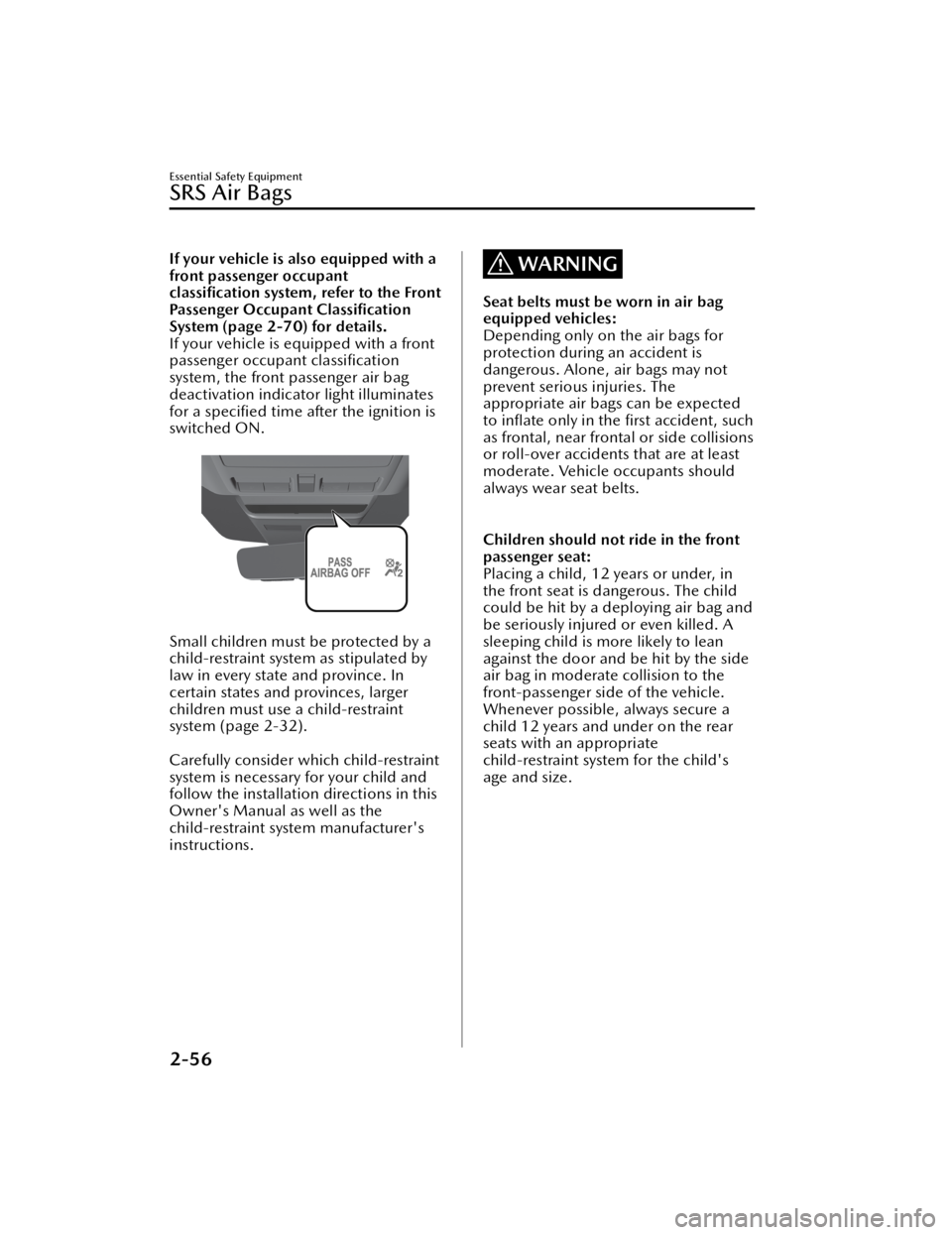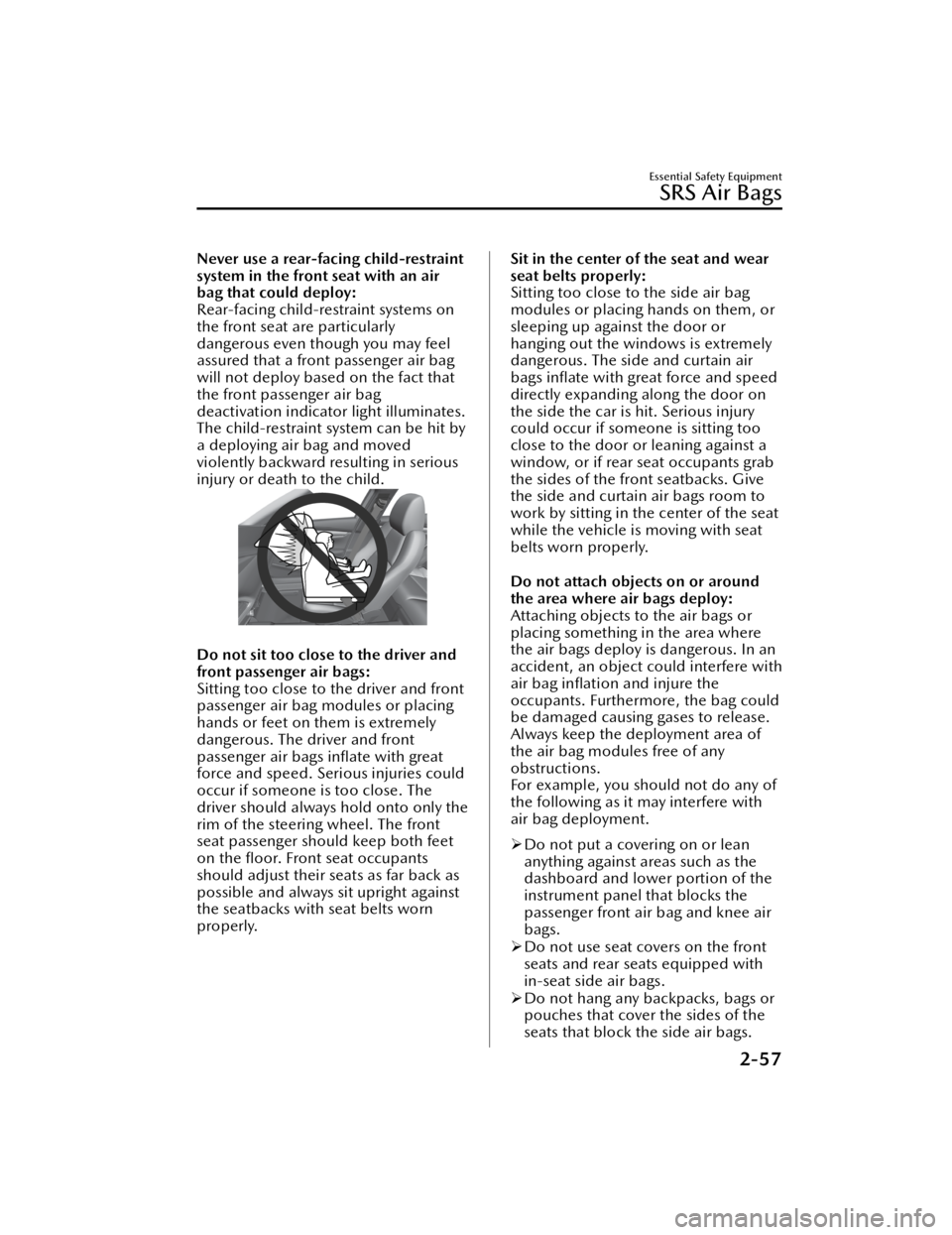seats MAZDA MODEL 3 HATCHBACK 2021 Owner's Guide
[x] Cancel search | Manufacturer: MAZDA, Model Year: 2021, Model line: MODEL 3 HATCHBACK, Model: MAZDA MODEL 3 HATCHBACK 2021Pages: 612, PDF Size: 89.06 MB
Page 65 of 612

Never attach two child-restraint
systems to the same ISOFIX/LATCH*1
lower anchor:
Attaching two child-restraint systems
to the same ISOFIX/LATCH
*1 lower
anchor is dangerous. In a collision, one
anchor may not be strong enough to
hold two child-restraint system
attachments, and it may break, causing
serious injury or death. If you use the
seat position for another child-restraint
system when an outboard ISOFIX/
LATCH
*1 position is occupied, use the
center seat belts instead, and the
tether if tether-equipped.
Make sure the child-restraint system is
properly secured:
An unsecured child-restraint system is
dangerous. In a sudden stop or a
collision it could move causing serious
injury or death to the child or other
occupants. Follow the child-restraint
system manufacturer's instructions on
belt routing to secure the seat just as
you would with a child in it so that
nobody is tempted to put a child in an
improperly secured seat later on.
When not in use, remove it from the
vehicle or fasten it with a seat belt, or
attach it to BOTH ISOFIX/LATCH
*1
lower anchors for ISOFIX/LATCH*1
child-restraint systems.
Make sure there are no seat belts or
foreign objects near or around the
ISOFIX/LATCH
*1 child-restraint
system:
Not following the child-restraint system
manufacturer's instructions when
installing the child-restraint system is
dangerous. If seat belts or a foreign
object prevent the child-restraint
system from being securely attached to
the ISOFIX/LATCH
*1 lower anchors
and the child-restraint system is
installed improperly, the child-restraint
system could move in a sudden stop or
collision causing serious injury or death
to the child or other occupants. When
installing the child-restraint system,
make sure there are no seat belts or
foreign objects near or around the
ISOFIX/LATCH
*1 lower anchors.
Always follow the child-restraint
system manufacturer's instructions.
*1ISOFIX (Mexico)/LATCH (Except Mexico)
Installation on rear outboard seats
1. First, adjust the front seat to allow clearance between the
child-restraint system and the front
seat.
Refer to Adjusting the Driver's Seat
on page 2-5.
Refer to Adjusting the Front
Passenger's Seat on page 2-13.
2. Make sure the seatback is securely latched by pushing it back until it is
fully locked.
Essential Safety Equipment
Child Restraint
2-51
Mazda3_8JM2-EA -20H_Edition1_new 2020-7-10 17:21:34
Page 67 of 612

2. Anchor bracket
(5–Door)
1. Tether strap
2. Anchor bracket
3. Forward
Always attach the tether strap to the
correct tether anchor position:
Attaching the tether strap to the
incorrect tether anchor position is
dangerous. In a collision, the tether
strap could come off and loosen the
child-restraint system. If the
child-restraint system moves it could
result in death or injury to the child.
Always install the head restraint and
adjust it to the appropriate position
after removing the child-restraint
system:
Driving with the head restraint
removed is dangerous as impact to the
occupant's head cannot be prevented
during emergency braking or in a
collision, which could result in a
serious accident, injury or death.
Refer to Head Restraints on page 2-17.
Installation on rear center seat
The ISOFIX/LATCH*1 lower anchors at
the center of the rear seat are much
further apart than the sets of ISOFIX/
LATCH
*1 lower anchors for
child-restraint system installation at
other seating positions. Child-restraint
systems with rigid ISOFIX/LATCH
*1
attachments cannot be installed on the
center seating position. Some ISOFIX/
LATCH
*1 equipped child-restraint
systems can be placed in the center
position and will reach the nearest
ISOFIX/LATCH
*1 lower anchors which
are 434 mm (17.1 in) apart. ISOFIX/
LATCH
*1 compatible child-restraint
systems (with attachments on belt
webbing) can be used at this seating
position only if the child-restraint
system manufacturer's instructions
state that the child-restraint system can
be installed to ISOFIX/LATCH
*1 lower
anchors that are 434 mm (17.1 in)
apart. Do not attach two child-restraint
systems to the same ISOFIX/LATCH
*1
lower anchor. If your child-restraint
system has a tether, it must also be
used for your child's optimum safety.
The procedure is the same as the
installation for the rear outboard seats.
*1ISOFIX (Mexico)/LATCH (Except Mexico)
Essential Safety Equipment
Child Restraint
2-53
Mazda3_8JM2-EA -20H_Edition1_new 2020-7-10 17:21:34
Page 70 of 612

If your vehicle is also equipped with a
front passenger occupant
classification system, refer to the Front
Passenger Occupant Classi fication
System (page 2-70) for details.
If your vehicle is equipped with a front
passenger occupant classi fication
system, the front passenger air bag
deactivation indicator light illuminates
for a speci fied time after the ignition is
switched ON.
Small children must be protected by a
child-restraint system as stipulated by
law in every state and province. In
certain states and provinces, larger
children must use a child-restraint
system (page 2-32).
Carefully consider which child-restraint
system is necessary for your child and
follow the installation directions in this
Owner's Manual as well as the
child-restraint system manufacturer's
instructions.
WARNING
Seat belts must be worn in air bag
equipped vehicles:
Depending only on the air bags for
protection during an accident is
dangerous. Alone, air bags may not
prevent serious injuries. The
appropriate air bags can be expected
to in flate only in the first accident, such
as frontal, near frontal or side collisions
or roll-over accidents that are at least
moderate. Vehicle occupants should
always wear seat belts.
Children should not ride in the front
passenger seat:
Placing a child, 12 years or under, in
the front seat is dangerous. The child
could be hit by a deploying air bag and
be seriously injured or even killed. A
sleeping child is more likely to lean
against the door and be hit by the side
air bag in moderate collision to the
front-passenger side of the vehicle.
Whenever possible, always secure a
child 12 years and under on the rear
seats with an appropriate
child-restraint system for the child's
age and size.
Essential Safety Equipment
SRS Air Bags
2-56
Mazda3_8JM2-EA -20H_Edition1_new 2020-7-10 17:21:34
Page 71 of 612

Never use a rear-facing child-restraint
system in the front seat with an air
bag that could deploy:
Rear-facing child-restraint systems on
the front seat are particularly
dangerous even though you may feel
assured that a front passenger air bag
will not deploy based on the fact that
the front passenger air bag
deactivation indicator light illuminates.
The child-restraint system can be hit by
a deploying air bag and moved
violently backward resulting in serious
injury or death to the child.
Do not sit too close to the driver and
front passenger air bags:
Sitting too close to the driver and front
passenger air bag modules or placing
hands or feet on them is extremely
dangerous. The driver and front
passenger air bags inflate with great
force and speed. Serious injuries could
occur if someone is too close. The
driver should always hold onto only the
rim of the steering wheel. The front
seat passenger should keep both feet
on the floor. Front seat occupants
should adjust their seats as far back as
possible and always sit upright against
the seatbacks with seat belts worn
properly.
Sit in the center of the seat and wear
seat belts properly:
Sitting too close to the side air bag
modules or placing hands on them, or
sleeping up against the door or
hanging out the windows is extremely
dangerous. The side and curtain air
bags in flate with great force and speed
directly expanding along the door on
the side the car is hit. Serious injury
could occur if someone is sitting too
close to the door or leaning against a
window, or if rear seat occupants grab
the sides of the front seatbacks. Give
the side and curtain air bags room to
work by sitting in the center of the seat
while the vehicle is moving with seat
belts worn properly.
Do not attach objects on or around
the area where air bags deploy:
Attaching objects to the air bags or
placing something in the area where
the air bags deploy is dangerous. In an
accident, an object could interfere with
air bag in flation and injure the
occupants. Furthermore, the bag could
be damaged causing gases to release.
Always keep the deployment area of
the air bag modules free of any
obstructions.
For example, you should not do any of
the following as it may interfere with
air bag deployment.
Do not put a covering on or lean
anything against areas such as the
dashboard and lower portion of the
instrument panel that blocks the
passenger front air bag and knee air
bags.
Do not use seat covers on the front
seats and rear seats equipped with
in-seat side air bags.
Do not hang any backpacks, bags or
pouches that cover the sides of the
seats that block the side air bags.
Essential Safety Equipment
SRS Air Bags
2-57
Mazda3_8JM2-EA -20H_Edition1_new 2020-7-10 17:21:34
Page 73 of 612

Do not modify a front door or leave
any damage unrepaired. Always have
an Authorized Mazda Dealer inspect a
damaged front door:
Modifying a front door or leaving any
damage unrepaired is dangerous. Each
front door has a side crash sensor as a
component of the supplemental
restraint system. If holes are drilled in a
front door, a door speaker is left
removed, or a damaged door is left
unrepaired, the sensor could be
adversely affected causing it to not
detect the pressure of an impact
correctly during a si de collision. If a
sensor does not detect a side impact
correctly, the side and curtain air bags
and the front seat belt pretensioner
may not operate norm ally which could
result in serious injury to occupants.
Do not modify the supplemental
restraint system:
Modifying the components or wiring of
the supplemental restraint system is
dangerous. You could accidentally
activate it or make it inoperable. Do
not make any modi fications to the
supplemental restraint system. This
includes installing trim, badges, or
anything else over the air bag modules.
It also includes installing extra
electrical equipment on or near system
components or wiring. An Authorized
Mazda Dealer can provide the special
care needed in the removal and
installation of front seats. It is
important to protect the air bag wiring
and connections to assure that the
bags do not accidentally deploy, and
that the front passenger occupant
classi fication system and the seats
retain an undamaged air bag
connection.Do not place luggage or other objects
under the front seats:
Placing luggage or other objects under
the front seats is dangerous. The
components essential to the
supplemental restraint system could be
damaged, and in the event of a side
collision, the appropriate air bags may
not deploy, which could result in death
or serious injury. To prevent damage to
the components essential to the
supplemental restraint system, do not
place luggage or other objects under
the front seats.
Do not operate a vehicle with
damaged air bag/seat belt
pretensioner system components:
Expended or damaged air bag/seat
belt pretensioner system components
must be replaced after any collision
which caused them to deploy or
damage them. Only a trained
Authorized Mazda Dealer can fully
evaluate these systems to see that they
will work in any subsequent accident.
Driving with an expended or damaged
air bag or pretensioner unit will not
a ff ord you the necessary protection in
the event of any subsequent accident
which could result in serious injury or
death.
Do not remove interior air bag parts:
Removing any components such as the
front seats, front dashboard, the
steering wheel or pa rts on the front
and rear window pillars and along the
roof edge, containing air bag parts or
sensors is dangerous. These parts
contain essential air bag components.
The air bag could accidentally activate
and cause serious injuries. Always have
an Authorized Mazda Dealer remove
these parts.
Essential Safety Equipment
SRS Air Bags
2-59
Mazda3_8JM2-EA -20H_Edition1_new 2020-7-10 17:21:34
Page 88 of 612

A rear passenger steps on the front
passenger seat rails with their feet.
Luggage or other items are placed on
the seatback or hung on the head
restraint.
Heavy items are placed in the
seatback map pocket.
The seat is washed.
Liquids are spilled on the seat.
The front passenger seat is moved
backward, pushing into luggage or
other items placed behind it.
The front passenger seatback
contacts the rear seat.
Luggage or other items are placed
between the front passenger seat
and driver seat.
Any accessories which might increase
the total seated weight on the front
passenger seat are attached to the
front passenger seat.
CAUTION
To assure proper deployment of the
front air bag and to prevent damage
to the sensors in the front seat
bottoms:
Do not place sharp objects on the
front seat bottoms or leave heavy
luggage on them.
Do not spill any liquids on the
front seats or under the front seats.
To allow the sensors to function
properly, always perform the
following:
Adjust the front seats as far back as
possible and always sit upright
against the seatbacks with seat
belts worn properly.
If you place your child on the front
passenger seat, secure the
child-restraint system properly and
slide the front passenger seat as far
back as possible (page 2-47).
NOTE
The system requires about 10
seconds to alternate between turning
the front passenger front and side air
bags and knee air bags, and seat belt
pretensioner system on or o ff.
The front passenger air bag
deactivation indicator light may
illuminate repeatedly if luggage or
other items are put on the front
passenger seat, or if the temperature
of the vehicle's interior changes
suddenly.
The front passenger air bag
deactivation indicator light may
illuminate for 10 seconds if the total
seated weight on the front passenger
seat changes.
The air bag/front seat belt
pretensioner system warning light
might illuminate if the front
passenger seat receives a severe
impact.
If the front passenger air bag
deactivation indicator light does not
illuminate after installing a
child-restraint system on the front
passenger seat,
first, re-install your
child-restraint system according to
the procedure in this owner's
manual. Then, if the front passenger
air bag deactivation indicator light
still does not illuminate, install the
child-restraint system on the rear seat
and consult an Authorized Mazda
Dealer as soon as possible.
Essential Safety Equipment
SRS Air Bags
2-74
Mazda3_8JM2-EA -20H_Edition1_new 2020-7-10 17:21:34
Page 114 of 612

Inside Trunk ReleaseLever (4-door)
*
▼Inside Trunk Release Lever
Your vehicle is equipped with an inside
trunk release lever that provides a
means of escape for children and
adults in the event they become locked
inside the trunk.
No matter how careful adults might be
with keys and locking their cars,
parents should be aware that children
may be tempted to play around
vehicles and use the trunk as a hiding
place.
Adults are advised to familiarize
themselves with the operation and
location of the inside trunk release
lever so that all children can be told
about it in an appropriate way, keeping
in mind that most vehicles do not have
such levers.
WARNING
Close the trunk lid, be sure the seat
backs are latched and do not allow
children to play inside the vehicle:
Leaving the trunk lid open or leaving
children in the vehicle with the keys is
dangerous. Children could open the
trunk lid and climb inside resulting in
possible injury or death from heat
exposure.
Always keep the car from being a
tempting place to play by latching the
rear seats, doors and the trunk, and
keeping the keys where children can
not play with them:
Leaving children or animals unattended
in a parked vehicle is dangerous.
Babies left sleeping and children who
lock themselves in cars or trunks can
die very quickly from heat prostration.
Do not leave your children or pets
alone in a car at any time. Do not leave
the car, the rear folding seats or the
trunk unlocked.
▼
Opening the Trunk Lid from the
Inside
Slide the inside trunk release lever in
the direction of the arrow. The lever is
made of material that will glow for
hours in the darkness of the trunk
following a brief exposure to ambient
light.
The inside trunk release lever is located
on the inside of the trunk lid.
Before Driving
Doors and Locks
3-24*Some models.
Mazda3_8JM2-EA
-20H_Edition1_new 2020-7-10 17:21:34
Page 127 of 612

Moonroof*
▼Moonroof
The moonroof can be opened or
closed when operating the overhead
tilt/slide switch at the front seats.
WARNING
Do not let passengers stand up or
extend part of the body through the
open moonroof while the vehicle is
moving:
Extending the head, arms, or other
parts of the body through the
moonroof is dangerous. The head or
arms could hit something while the
vehicle is moving. This could cause
serious injury or death.
Never allow children to play with the
tilt/slide switch:
The tilt/slide switch would allow
children to operate the moonroof
unintentionally, which could result in
serious injury if a child's hands, head
or neck becomes caught by the
moonroof.
Make sure the opening is clear before
closing the moonroof:
A closing moonroof is dangerous. The
hands, head, or even neck of a person,
especially a child, could be caught in it
as it closes, causing serious injury or
even death.
Make sure nothing blocks the
moonroof just before it reaches the
fully closed position:
Blocking the moonroof just before it
reaches the closed position is
dangerous.
In this case, the jam-safe function
cannot prevent the moonroof from
closing. If
fingers are caught, serious
injuries could occur.
CAUTION
Do not sit on or put heavy items on
the area where the moonroof opens
and closes. Otherwise, the
moonroof could be damaged.
Do not open or close the moonroof
forcefully during freezing
temperatures or snowfall. Otherwise,
the moonroof could be damaged.
The sunshade does not tilt. To avoid
damaging the sunshade, do not push
it up.
Do not close the sunshade while the
moonroof is opening. Trying to force
the sunshade closed could damage
it.
Before Driving
Windows
*Some models.3-37
Mazda3_8JM2-EA -20H_Edition1_new 2020-7-10 17:21:34
Page 233 of 612

*1 The recognition distance of the ForwardSensing Camera (FSC) varies according to
the surrounding conditions.
The warning light turns on when the
system has a malfunction.
Refer to High Beam Control System
(HBC) Warning Indication/Warning
Light (Amber) on page 7-34.
CAUTION
Do not adjust the vehicle height,
modify the headlight units, or
remove the camera, otherwise the
system will not operate normally.
Do not rely excessively on the HBC
and drive the vehicle while paying
su fficient attention to safety. Switch
the headlights between the high
beams and low beams manually if
necessary.
NOTE
The timing in which the system
switches the headlights changes under
the following conditions. If the system
does not switch the headlights
appropriately, manually switch
between high and low beams
according to the visibility as well as
road and tra ffic conditions.
When there are sources of light in
the area such as street lamps,
illuminated signboards, and tra ffic
signals.
When there are re flective objects in
the surrounding area such as
re flective plates and signs.
When visibility is reduced under rain,
snow and foggy conditions.
When driving on roads with sharp
turn or hilly terrain.
When the headlights/rear lamps of
vehicles in front of you or in the
opposite lane are dim or not
illuminated.
When there is insu fficient darkness
such as at dawn or dusk.
When the trunk/luggage
compartment is loaded with heavy
objects or the rear passenger seats
are occupied.
When visibility is reduced due to a
vehicle in front of you spraying water
from its tires onto your windshield.
▼ To Operate the System
The HBC operates to switch the
headlights automatically between high
and low beams after the ignition is
switched ON and the headlight switch
is in the AUTO and low beam position.
The HBC determines that it is dark
based on the brightness of the
surrounding area. At the same time,
the HBC indicator light (green) in the
instrument cluster illuminates.
NOTE
Operation of the HBC function can be
disabled.
Refer to the Settings section in the
Mazda Connect Owner's Manual.
When Driving
i-ACTIVSENSE
4-91
Mazda3_8JM2-EA
-20H_Edition1_new 2020-7-10 17:21:34
Page 350 of 612

Do not adhere stickers (including
transparent stickers) to the surface of
the radiator grille and front emblem
in and around the front radar sensor,
and do not replace the radiator grille
and front emblem with any product
that is not a genuine product
designed for use with the front radar
sensor.
The front radar sensor includes a
function for detecting soiling of the
radar sensor's front surface and
informing the driver, however,
depending on the conditions, it may
require time to detect or it may not
detect plastic shopping bags, ice or
snow. If this occurs, the system may
not operate correctly, therefore
always keep the front radar sensor
clean.
Do not install a grille guard.
If the front part of the vehicle has
been damaged in a vehicle accident,
the position of the front radar sensor
may have moved. Stop the system
immediately and always have the
vehicle inspected at an Authorized
Mazda Dealer.
Do not use the front bumper to push
other vehicles or obstructions such
as when pulling out of a parking
space. Otherwise, the front radar
sensor could be hit and its position
deviated.
Do not remove, disassemble, or
modify the front radar sensor.
For repairs, replacement or paint
work around the front radar sensor,
consult an Authorized Mazda Dealer.
Do not modify the suspensions. If
the suspensions are modi fied, the
vehicle's posture could change and
the front radar sensor may not be
able to correctly detect a vehicle
ahead or an obstruction.NOTE
Under the following conditions, the
front radar sensor may not be able to
detect vehicles ahead or obstructions
correctly and each system may not
operate normally.
The rear surface of a vehicle ahead
does not reflect radio waves
e ff ectively, such as an unloaded
trailer or an automobile with a
loading platform covered by a soft
top, vehicles with a hard plastic
tailgate, and round-shaped
vehicles.
Vehicles ahead with low vehicle
height and thus less area for
re flecting radio waves.
Visibility is reduced due to a
vehicle ahead casting off
water,
snow, or sand from its tires and
onto your windshield.
The trunk/luggage compartment is
loaded with heavy objects or the
rear passenger seats are occupied.
Ice, snow, or soiling is on the front
surface of the front emblem.
During inclement weather such as
rain, snow, or sand storms.
When driving near facilities or
objects emitting strong radio
waves.
Under the following conditions, the
front radar sensor may not be able to
detect vehicles ahead or
obstructions.
The beginning and end of a curve.Roads with continuous curves.Narrow lane roads due to road
construction or lane closures.
The vehicle ahead enters the radar
sensor's blind spot.
The vehicle ahead is running
abnormally due to accident or
vehicle damage.
When Driving
i-ACTIVSENSE
4-208
Mazda3_8JM2-EA -20H_Edition1_new 2020-7-10 17:21:34